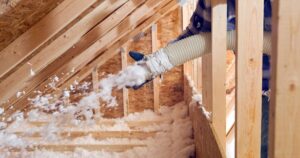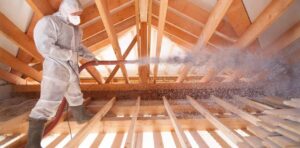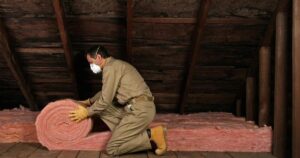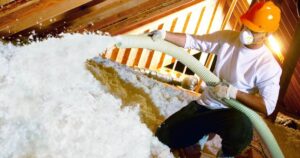Whether tap insulation is worth it depends on various factors, including your specific needs and circumstances. Tap insulation, also known as blown-in insulation, is a method of insulating your home by blowing insulation material into wall cavities, attics, or other areas.
When it comes to optimizing your home’s energy efficiency and comfort, you’ve likely heard about the wonders of Tap Insulation. But is it truly worth the investment? In a world where energy costs are on the rise and climate change is a pressing concern, finding ways to improve the insulation in your home can be a game-changer.
Some considerations to help you determine if it’s worth it for your situation
Efficiency
Proper insulation can significantly improve the energy efficiency of your home. If you live in a region with extreme temperatures, tap insulation can help regulate indoor temperatures, reducing heating and cooling costs. This can lead to long-term savings on your energy bills.
Comfort
Adequate insulation can make your home more comfortable by maintaining a consistent temperature and reducing drafts. This can also enhance your overall quality of life.
Cost Savings
While there is an upfront cost to install tap insulation, the energy savings can offset this expense over time. Calculate the potential return on investment by comparing the installation cost to your expected energy savings.
Environmental Impact
Improved insulation can reduce your carbon footprint by lowering energy consumption. If environmental sustainability is a priority, tap insulation can be a worthwhile investment.
Home Value
Upgrading your home’s insulation can increase its resale value. Potential homebuyers often appreciate energy-efficient features, which can make your property more attractive on the market.
Local Climate
Consider the climate in your region. In colder or hotter climates, insulation is generally more important for maintaining indoor comfort and reducing energy costs.
Existing Insulation
If your home already has insulation, assess its condition. If it’s old or damaged, adding tap insulation can be a cost-effective way to improve insulation levels without extensive renovations.
Financial Incentives
Some regions offer incentives or rebates for homeowners who invest in energy-efficient upgrades, including insulation. Check if there are any local programs that can help offset the installation cost.
Health Benefits
Proper insulation can contribute to a healthier indoor environment by reducing moisture and preventing the growth of mold and mildew.
Sound Insulation
In addition to thermal benefits, tap insulation can also provide some level of sound insulation, making your home quieter.
Pros and Cons Tap insulation

To determine if tap insulation is worth it, you should consult with a professional insulation contractor to assess your home’s current insulation, discuss your goals, and receive a cost estimate. They can provide specific recommendations based on your unique situation. The decision to invest in tap insulation should take into account both the short-term costs and long-term benefits.
Tap insulation, also known as blown-in insulation, has several advantages and disadvantages. Here are some of the pros and cons of using tap insulation:
Pros
- Energy Efficiency
One of the primary advantages of tap insulation is its ability to improve the energy efficiency of a home. It helps to reduce heat loss in the winter and heat gain in the summer, thereby lowering heating and cooling costs.
- Easy Installation
Blown-in insulation is relatively quick and easy to install, making it a cost-effective choice for adding insulation to existing homes. It can be blown into wall cavities, attics, and other hard-to-reach spaces without major renovations.
- Uniform Coverage
Blown-in insulation provides a more consistent and uniform coverage compared to traditional Tab insulation. This helps to eliminate gaps and voids, providing better thermal performance.
- Sound Insulation
In addition to thermal benefits, tap insulation can also offer some degree of sound insulation, reducing noise from the outside and between rooms.
- Environmentally Friendly
Many blown-in insulation materials are made from recycled or sustainable materials, making them more eco-friendly options.
- Moisture Control
Some types of tap insulation, like cellulose, have natural moisture-controlling properties, which can help prevent mold and mildew growth.
- Versatility
Blown-in insulation can be used in various parts of a home, including attics, walls, and crawl spaces, making it versatile for different insulation needs.
Cons
- Professional Installation
While it can be a DIY project, professional installation is often recommended to ensure proper coverage and safety. This adds to the overall cost.
- Initial Cost
The initial cost of installing tap insulation can be higher than some other insulation methods. However, long-term energy savings may offset this cost.
- Settling
Over time, some types of blown-in insulation may settle, reducing their effectiveness. Periodic maintenance or topping up may be required.
- Fire Hazard
Depending on the material used, some tap insulation types can be flammable. Proper safety measures and fire-resistant materials must be used in specific areas.
- Pest Concerns
If not properly installed and sealed, blown-in insulation can attract pests like rodents or insects.
- Allergies and Health Concerns
Certain insulation materials, such as fiberglass, can cause skin irritation and respiratory issues for individuals with sensitivities or allergies.
- Access for Retrofitting
It may be challenging to retrofit blown-in insulation in some areas with limited access, which could necessitate modifications to the structure.
Conclusion
Tap insulation offers excellent thermal performance, ease of installation, and environmental benefits. However, it should be installed professionally for optimal results, and homeowners should consider the initial cost, long-term maintenance, and safety factors when choosing this insulation method. The choice of insulation material should also be made carefully, considering individual needs and preferences.
FAQs
Is tap insulation safe?
Borates are deadly to insects yet have extremely low toxicity to mammals. Therefore, the risk is minimal to people and pets. Unlike most traditional pesticide chemicals, TAP® Pest Control Insulation is applied behind walls and in attics where exposure to people and pets is extremely limited.
Does tap insulation smell?
No. TAP® Pest Control Insulation does not have an odor ad there is no off-gassing found in much other insulation. The borates in TAP® Pest Control Insulation actually help absorb and reduce any foul odors.
Can insulating foam get wet?
Any water that meets open cell spray foam is completely drained away, meaning it cannot be absorbed and therefore damage your insulation.










